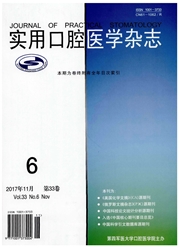

 中文摘要:
中文摘要:
目的:建立髁突矢状骨折继发颞下颌关节强直动物模型。方法:实验用小型猪4头。手术造成右侧髁突矢状骨折,切除部分关节盘,破坏颞骨和髁突的关节面,制动关节。术前及术后4个月测量下颌张口度,作CT检查,进行组织学分析。结果:实验动物中的2只术后4个月时张口度减小近1/2;CT显示关节窝与和髁突之间有骨痂形成;组织学证实关节窝与髁突之间被大量纤维组织占据,其中间杂有新生骨岛和骨桥。结论:初步成功建立髁突矢状骨折继发关节强直的动物模型,但可重复性有待改善。
 英文摘要:
英文摘要:
Objective:To establish an animal model of temporomandibular joint ankylosis induced by condylar sagittal fracture. Methods: Four miniature pigs were used to create experimental model. A sagittal fracture was performed from the top surface of lateral 1/3 of condylar head running downward in oblique line. Temporal and condylar articular surfaces were crushed by using drill bit, and the lateral half of disk was removed in the meanwhile. The sliding motion of joint was restricted with wire ligature between fossa and condylar head. The range of mouth opening was recorded preop- eratively and at the 4th month postoperatively. CT was taken for each to clue on image change. The harvested ankylosed tissue was histologically examined to validate the appearance of newly forming bony island or bony bridge connecting joint shores. Results : The range of mouth opening decreased by 1/2 at 4th month postoperatively in two miniature pigs. For both, callus-like image appeared on CT scan. In histological examination, irregularly distributed ossified fibrous tissue was found in the involved area. Conclusion: An animal model of condylar fracture-induced joint ankylosis is preliminarily established, but the reproducibility remains for further improved.
 同期刊论文项目
同期刊论文项目
 同项目期刊论文
同项目期刊论文
 Clinical investigation of early post-traumatic temporomandibular joint ankylosis and the role of rep
Clinical investigation of early post-traumatic temporomandibular joint ankylosis and the role of rep Etiology of temporomandibular joint ankylosis secondary to condylar fractures: The role of concomita
Etiology of temporomandibular joint ankylosis secondary to condylar fractures: The role of concomita Clinical investigation of early post-traumatic temporomandibular joint ankylosis and the role of rep
Clinical investigation of early post-traumatic temporomandibular joint ankylosis and the role of rep 期刊信息
期刊信息
